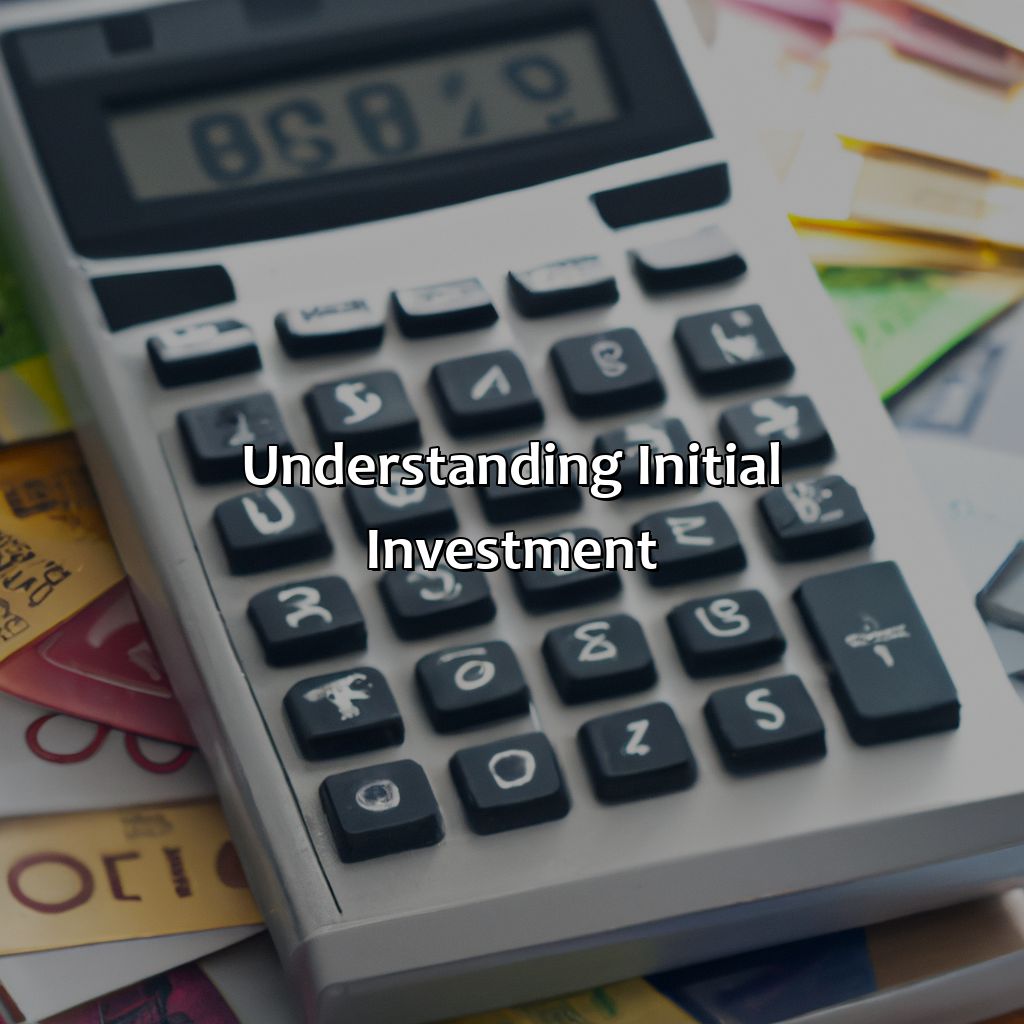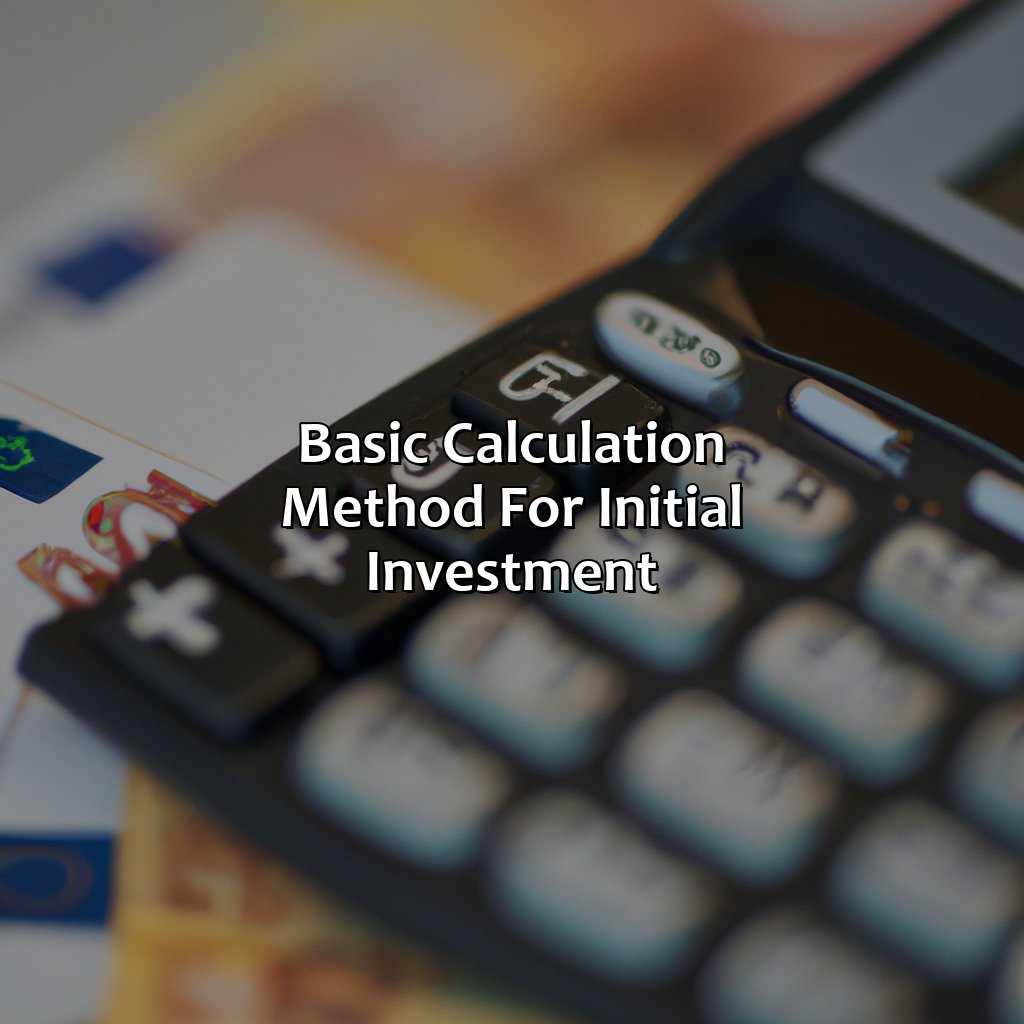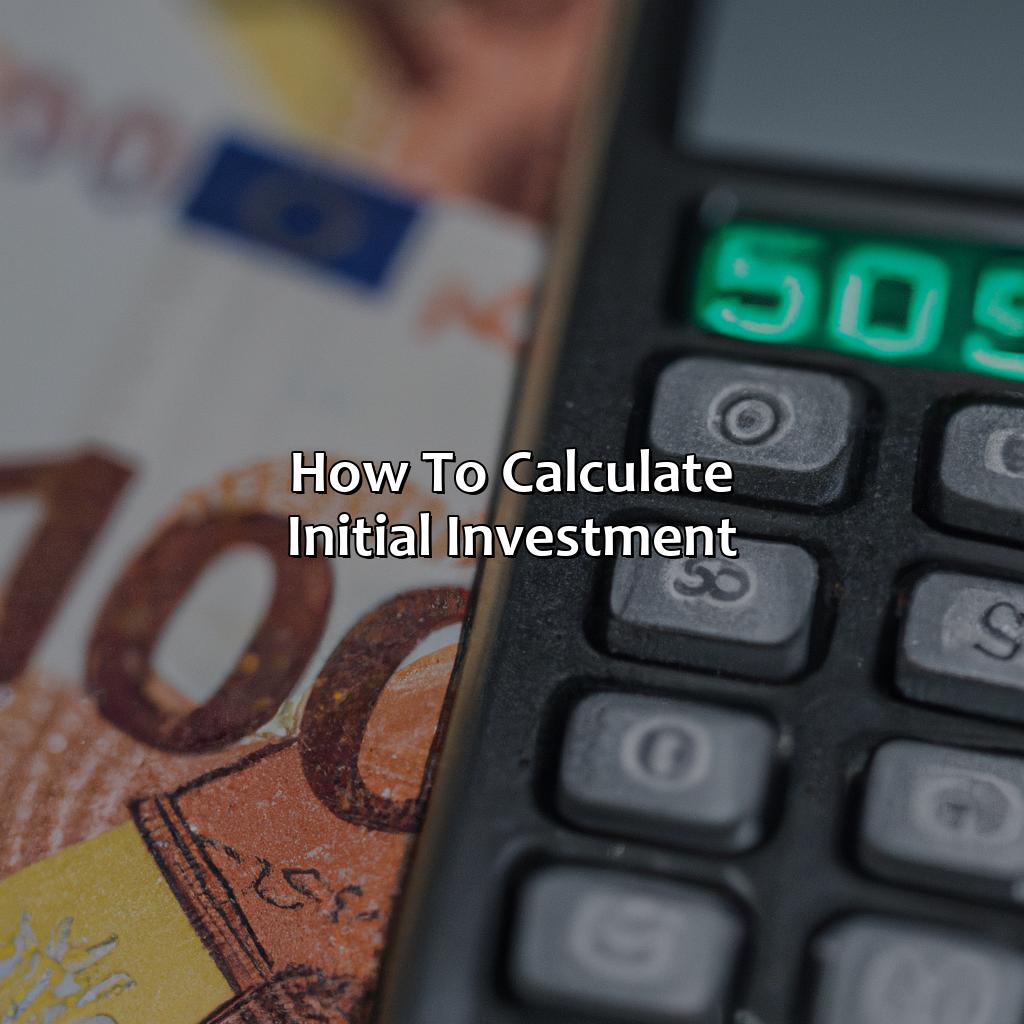How To Calculate Initial Investment?
Key Takeaway:
- Initial investment refers to the amount of money required to start a business or project. Calculating initial investment is important as it determines the feasibility and sustainability of the venture.
- Factors to consider while calculating initial investment include the cost of equipment and machinery, planning and development costs, marketing costs, legal fees, labour costs, and overhead expenses.
- The basic calculation method for initial investment includes summing up all the costs, depreciation calculation, and net present value (NPV) evaluation. It is essential to seek professional assistance to ensure accurate calculation.
Ready to start your own business but not sure how to calculate the initial investment? You can get started with the right calculation tools and knowledge. This article will guide you through how to calculate your initial investment to ensure the success of your business.
Understanding Initial Investment
Gain insight into initial investment by understanding its definition. Calculating it is also essential. This will empower you to make wise decisions about the money needed to begin or broaden a business.

Image credits: retiregenz.com by Joel Washington
Definition of Initial Investment
Initial investment refers to the initial financial outlay required for a project or business venture. It includes the cost of acquiring assets such as equipment, facilities, and licenses, as well as expenses incurred during the planning and set-up phase.
To calculate the initial investment, one must identify all relevant costs associated with starting the venture and estimate their values. These costs may vary depending on the type of project or business. The calculation should also take into consideration any future revenue streams that may offset initial costs.
It is crucial to accurately estimate the initial investment as it affects profitability and long-term success. Neglecting certain costs could lead to insufficient funding, delays in operation, or even failure of the venture.
Understanding how to calculate initial investment is a critical aspect of launching a successful business or project. By identifying all necessary costs from the outset, one can ensure proper financing and achieve profitable outcomes in the long run. Don’t miss out on starting your venture off on the right foot by neglecting this important step.
Calculating initial investment is like checking the price tag before swiping your credit card – it saves you from a lot of regret later on.
Importance of Calculating Initial Investment
Calculating the initial investment is a crucial first step before investing in any project. Allocating funds needs to be done with precision and accuracy, as it sets the foundation for future financial decisions. Knowing exactly how much capital will be needed from the get-go can help determine the profitability of the investment. Without calculating initial investment, failure or loss of funds may occur.
By understanding how to calculate initial investment, investors can make informed decisions about which opportunities are viable and profitable. Factors such as capital expenditures, cash reserves, and operating costs must be considered when determining the total amount required to start a project successfully.
It is important to note that initial investment could vary depending on what type of investment option one selects. For example, a different industry will have unique requirements for equipment and regulatory compliance that will impact initial costs significantly.
A successful entrepreneur once shared his story of starting a small retail store without realizing he had underestimated his initial investment needs. By miscalculating these financial requirements, he faced unexpected problems such as insufficient inventory and cash flow issues. With limited resources at his disposal, this entrepreneur ultimately had to sell the store at a loss. This is an example of why accurately calculating initial investment is essential for long-term success in any business endeavour.
Calculating initial investment is like being a detective – you need to uncover all the factors that could impact your bottom line.
Factors to Consider While Calculating Initial Investment
To work out your business’s first investment, you need to think about different factors. To figure out the total sum you’ll need to launch your business, you must look at costs for:
- equipment and machinery
- planning and development
- legal fees
- marketing
- labor
- overhead expenses
These sub-sections will give advice on how to sort out these costs precisely while calculating your initial investment.

Image credits: retiregenz.com by Harry Arnold
Cost of Equipment and Machinery
The investment required for acquiring adequate machinery and equipment is a crucial consideration when evaluating the initial cost of starting a business.
A table is a useful approach to illustrate the various costs associated with purchasing machinery and equipment. The “Costs Associated with Machinery and Equipment” chart lists items such as initial purchase expenditure, transportation costs, installation costs, and training expenses. In addition, ongoing expenses such as maintenance fees, repair fees, and warranty periods must be considered.
Alongside the costs outlined in paragraph two, additional unique details that must be taken into account include the duration of machinery leases or loans, depreciation rates based on wear and tear over time, and resale value estimates during assessment periods.
When considering the best course of action for financing initial equipment purchases, small business owners should evaluate all options thoroughly. Suggestions include researching equipment leasing agreements from reputable financial institutions like banks or other lending institutions; approaching manufacturers directly to explore financing options unique to their particular products; or exploring tax incentives provided by relevant local or national government entities. It’s essential to make an informed choice based on current circumstances and future prospects while balancing available funding opportunities.
Planning and development costs can be a real headache, but just remember: investing in a good calculator is cheaper than hiring an accountant.
Planning and Development Costs
When considering the initial investment for a project, it is essential to account for expenses related to the planning and development stage. These costs can include market research, feasibility studies, prototype development, and other expenses necessary to bring the idea to fruition.
It is vital to identify all relevant planning and development costs at an early stage when calculating the initial investment. This helps in identifying potential obstacles and risks in advance while also making sure that sufficient funds are allocated to these critical stages of project development.
Innovative technology and revolutionary ideas require more extensive planning and greater investment in research and development than conventional projects. Therefore, a thorough analysis of these costs should be conducted before starting any project.
Pro Tip: There has been a tremendous evolution of technologies that aid businesses in financial management on the clouds like AI-enabled accounting software. It’s essential to leverage such tools while evaluating cost factors.
Marketing costs can add up quickly, so make sure you’re selling something people actually want, not just a pile of disappointment wrapped in a pretty package.
Marketing Costs
When calculating initial investment, it’s essential to consider expenses related to promoting your business or product. These expenses are commonly known as Branding and Advertising Costs. In this phase, you should be ready to allocate a significant percentage of your initial capital towards defining your target audience, creating brand awareness, developing a marketing plan, and executing it.
A thorough analysis of Marketing Costs is essential for determining the right strategy and allocating budgets accordingly. You must evaluate each platform’s effectiveness in terms of reaching your target audience and the costs involved in acquiring customers through them. Digital media platforms like Facebook, Instagram, Twitter, YouTube & LinkedIn offer cost-effectiveness in terms of customer acquisition compared to traditional methods.
Other important factors that need consideration include the Cost per Acquisition (CPA), Customer Lifetime Value (CLTV), Return on Ad Spend (ROAS), and Key Performance Metrics(KPIs) such as audience engagement rates and conversion rates. Utilizing these tools will help you establish realistic goals and measure progress efficiently.
Pro Tip: When it comes to Marketing Costs determination and budget allocation, start by testing multiple techniques across various channels; once they have proven effective at driving results while staying within budget – ramp up your efforts!
Why pay for a lawyer when you can handle the legal fees yourself and have an excuse for any future mistakes?
Legal Fees
The fees associated with legal proceedings are an important consideration when calculating initial investments. These expenses can encompass fees for lawyers, court filings, and paperwork. Legal Fees may also include costs related to licensing, permits, or regulatory compliance.
Fees vary depending on the type and complexity of the case and thus require diligent review. Inadequate research can result in unexpected legal expenses that could ruin your investment plans.
One essential fact to note is that hiring an experienced attorney would reduce risks and aid in creating solid plans. The costs of legal services should be grounded in a sensible assessment of the client’s needs while taking into account the expected results of any action taken.
It is always a good idea to have some wiggle room in your budget to handle unexpected expenses like Legal Fees. Otherwise, neglecting this influential factor can potentially undermine your overall investment success.
A local businessman once shared his story where noncompliance with legal regulations led to significant fines, rendering his enterprise insolvent. Minimizing this risk by seeking professional guidance proved instrumental in salvaging business assets.
Remember, employing someone costs more than just their salary – you’ve also got to factor in the cost of occasionally pretending to care about their personal life.
Labour Costs
When considering the expenses for starting a business, it is crucial to take into account the costs associated with personnel. Workforce expenditures include salaries, employee benefits, training costs, and other expenses related to hiring and retaining staff. These investments must be weighed against the potential revenues that are generated by having employees on board.
The size and expertise level of your team will affect your initial investment. Before calculating labour costs in your overall calculation of business expenses, you need to determine how much man-hours are needed to get the work done. This will give you a fair idea of how many full-time or part-time workers you’ll require and their assistance in achieving your objectives beforehand.
Labour expense cannot be significantly reduced without affecting the quality of work rendered or customer service levels. Still, there exist several methods for reducing expenditure on labour costs considerably while still providing high-quality service to your clients. For example, determining which positions require highly skilled personnel versus those that do not can aid businesses in reducing their labour costs without compromising on productivity.
During one of our operations, we weren’t able to hire enough staff since they were expensive and led us down a different route – outsourcing local workers at an affordable cost. It proved successful as we saved money and didn’t compromise quality service provision.
Overhead expenses are like a bad haircut – you never realize how much they’re affecting you until it’s too late.
Overhead Expenses
The costs not directly associated with production are known as administrative expenses. These expenses can include items such as rent, utilities, insurance, and advertising. It’s important to account for these overhead expenses when calculating the initial investment for a project or business.
Considering overhead expenses is essential because they can significantly impact the financial viability of a project or business. Failing to include them in cost projections can lead to underestimating costs and ultimately jeopardize profitability.
One critical aspect of overhead expenses that usually goes unnoticed is their contribution to fixed costs. They do not vary with changes in production volume, which means they remain constant regardless of how much you produce. Thus, it’s crucial to have a well-defined strategy in place while planning your overheads.
According to the Small Business Administration (SBA), startups should plan on covering three-to-six months worth of expenses before generating profits sustainably.
(Source: https://www.sba.gov/business-guide/plan-your-business/calculate-your-startup-costs)
Rack your brains, not your wallet – follow these simple steps to calculate your initial investment!
Basic Calculation Method for Initial Investment
To figure out your first investment for a project, comprehend the basic calculation method. Sum up all costs, compute depreciation, and identify the Net Present Value (NPV). These three sub-sections can aid you in finding the best possible solution. They will further clarify the value of each calculation process.

Image credits: retiregenz.com by Adam Jones
Summing up all the Costs
To calculate the total initial investment costs, all expenses must be accumulated and summed up. This includes the cost of purchasing assets, employee salaries during the first few months, rent payments for business locations, equipment and tool purchases, marketing fees, legal and licensing fees and anything else relevant to starting a business.
A detailed table on ‘Calculating All Initial Investment Costs’ is shown below:
| Costs | Amount ($) |
|---|---|
| Asset Purchases | 15,000 |
| Employee Salaries | 10,000 |
| Rent Payment | 5,000 |
| Equipment and Tools | 6,000 |
| Marketing Fees | 3,000 |
| Legal Fees and License | 2,000 |
After adding up all these individual costs together you can gather a clear picture of how much one would need to invest initially before starting their business.
It’s important to note that every business has its unique set of costs so it’s best to factor in even minor details while calculating initial investment costs accurately.
According to “Small Business Administration“, An appropriate estimate for start-up equipment is $75k.
Depreciation may sound depressing, but it’s just another calculation that helps your investment stay on the up-and-up.
Depreciation Calculation
When it comes to calculating the decrease in value of an asset over time, the process is known as Asset Depreciation.
To calculate Depreciation for an asset, first, determine its useful life. Then, determine its salvage value or the amount it can be sold for after useful life. Lastly, subtract the salvage value from the cost of the asset and divide that number by its useful life. This will give you the depreciation per year.
| Asset Cost | Useful Life (in years) | Salvage Value | Depreciation per Year |
| $10,000 | 5 | $1,000 | $1,800 |
It’s important to note that there are different methods to calculate depreciation such as straight-line method and declining balance method. The method used will depend on various factors including tax laws and organizational policies.
Don’t miss out on accurately calculating Depreciation! Use this basic calculation method to ensure you’re properly accounting for your assets and their value over time.
Calculating NPV may require some mental gymnastics, but the end result will have you doing a victory dance that would make Simone Biles jealous.
Net Present Value (NPV)
Calculating the present value of future cash flows is critical for determining the profitability of a project. NPV is a method that measures the difference between an investment’s current value and its initial cost, factoring in inflation and expected rates of return.
This formula takes into account both the timescale over which the investment will deliver returns and the expected size of those returns, translating all these factors back to their present-day values. By calculating an NPV, investors are better able to gauge whether or not an investment opportunity is worth pursuing.
It’s also important to note that while calculating NPV by hand can be challenging, there are many financial calculators and software programs available that make this process much more manageable.
When conducting an NPV calculation, it’s essential to make informed assumptions regarding interest rates, use conservative estimates when calculating expected cash flows and consider other contributing factors like taxes or potential risks. By using accurate information and thoughtful analysis during your calculations, you enhance your ability to generate accurate results and make better business decisions accordingly.
Calculating initial investment may be a daunting task, but hey, at least it’s not as risky as letting your cousin invest in your business idea.
Importance of Accurate Calculation
Accurate calculation is crucial while determining the initial investment for any project. Miscalculation can result in underestimating or overestimating the cost, leading to financial loss or project failure. Precise information regarding expenses and potential income is vital for making informed decisions.
To ensure accurate calculation, it is important to gather complete and reliable data, including expenses like purchases, salaries, and overheads. This can be done by relying on accounting software or professional consultants who specialize in financial estimations.
Moreover, a thorough analysis of market trends, customer demand and competition is crucial to predict future income correctly. Inaccurate predictions can lead to wrong business decisions and long-term losses.
Let’s recap…or as some call it, ‘re-calculate’…the factors to consider before investing your hard-earned cash.
Recapitulation of Factors to Consider
To summarize the essential elements to account for when calculating the initial investment, we need to consider certain factors that will influence it. These are not limited to but include market research, legal fees, production costs, marketing strategies, operation expenses and contingency plans.
- Market Research: Understand the target audience and analyze competition.
- Legal Fees: Consult with a lawyer and verify costs and laws regarding permits.
- Production Costs: Determine material costs, labor expense, and tool expenses.
- Marketing Strategies: Decide on advertising platforms and associated costs with promotion.
- Operation Expenses: Anticipate overhead expenditure during initial operations.
- Contingency Plans: Plan for unexpected issues preventing a substantial increase in investment needs.
Meticulous planning will allow you to estimate how much capital should be invested initially in your business. Do not overlook leveraging Artificial Intelligence-based financing tools that easily let one calculate such amounts while providing personalized attention as per your industry verticals.
A new startup founder did not consider factoring supply-chain management into the initial investment calculation since they were using off-the-shelf software. However, their revenue was highly dependent on products being delivered on time. Unfortunately, one of their suppliers delayed delivery by two weeks; this caused them major issues. The delay incurred additional charges towards fulfilling orders while damaging their reputation among clients.
Suggestion for Professional Assistance.
A Professional’s Help to Assess Your Investment:
Finding out the initial investment for your business idea is crucial, and as a beginner, it could be daunting. Seeking professional assistance from experienced financial advisors might help you make sound investment decisions. They can provide in-depth analysis of your business plan, evaluate risks and returns, recommend investment options, and offer tax planning strategies that align with your interest.
Furthermore, financial professionals use various quantitative models to project future earnings of your business over a period providing you a clear picture of the return on investment. Their expertise helps you overcome the common pitfalls and ensures regulatory compliance.
In addition to this, they keep themselves updated with the latest market trends to provide you with informative insights. Seeking their advice can help lay a strong foundation for your business while mitigating potential risks.
Don’t hesitate to connect with an advisor today – investing in expert opinion can avoid losing big in the future.
Five Facts About How To Calculate Initial Investment:
Initial investment is the amount of money needed to start a business or a project. (Source: Investopedia)
Some common methods to calculate initial investment include the payback period method, the discounted cash flow method, and the net present value method. (Source: Small Business Chronicle)
The payback period method calculates the amount of time it takes for a project to break even and the initial investment to be recovered. (Source: The Balance Small Business)
The discounted cash flow method considers the time value of money and calculates the present value of future cash flows. (Source: Cleverism)
The net present value method calculates the present value of all cash inflows and outflows related to a project and compares it to the initial investment. (Source: Corporate Finance Institute)
FAQs about How To Calculate Initial Investment?
How do I calculate initial investment?
Calculating initial investment involves identifying all the costs required to start a business or invest in a project. To calculate your initial investment, you should add up all the expenses associated with starting a project, including equipment, permits, licensing fees, and any other necessary expenses.
What are some of the common costs associated with initial investments?
Some of the common costs associated with initial investments include equipment costs, leasehold improvements, startup costs, licensing fees, and legal fees. Other expenses that may factor into an initial investment include marketing and advertising costs, website development, and supplies.
Can I use a formula to calculate initial investment?
While there is no specific formula for calculating initial investment, you can develop a thorough list of expenses and add them up to determine the total cost of starting your business or investment. This can include everything from fixed costs like rent and equipment purchases to variable costs like salaries and marketing expenses.
How do I prioritize expenses when calculating my initial investment?
When prioritizing expenses for your initial investment, consider which costs are necessary to get your business up and running and which can be deferred until later. Additionally, consider the potential return on investment for each expense and decide which investments provide the most value for your business.
What factors should I consider when calculating my initial investment?
Some of the factors to consider when calculating your initial investment include fixed costs, variable costs, the potential return on investment, and the timeframe for generating revenue. Additionally, you should evaluate the risks associated with your investment and consider factors like competition and market demand.
How can I minimize initial investment costs?
One way to minimize initial investment costs is to determine which expenses are absolutely necessary for getting your business up and running and which can be deferred until later. You may also be able to negotiate better prices for equipment or supplies or consider alternative financing options to reduce upfront costs.
 Checkout this IRS Loophole
Checkout this IRS Loophole 
